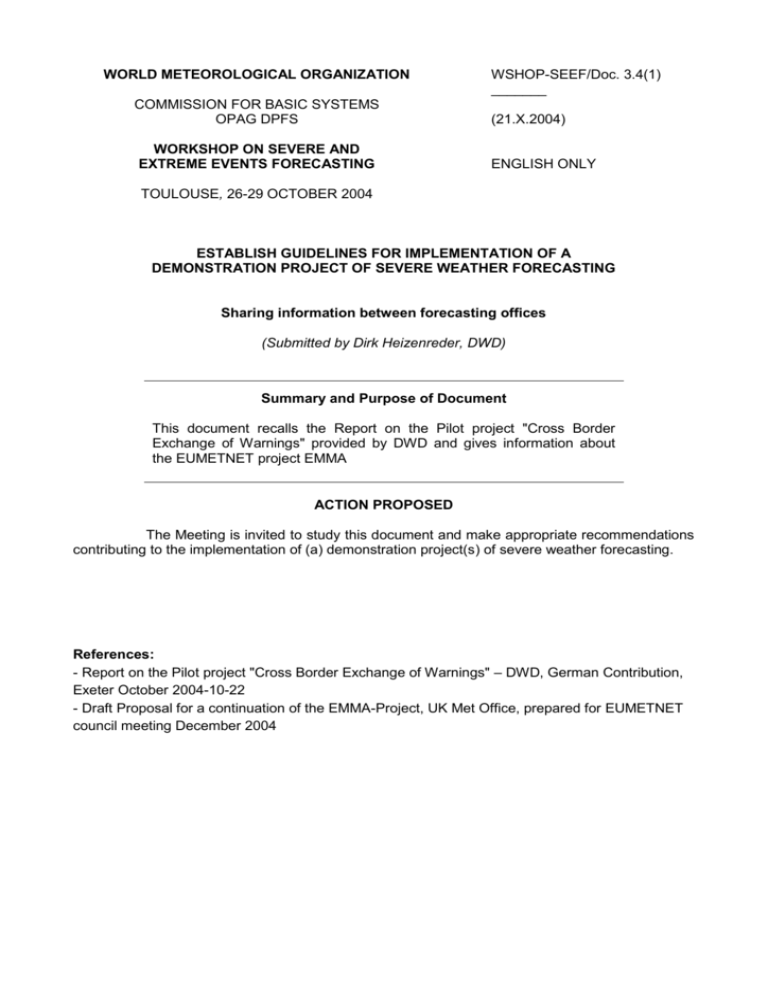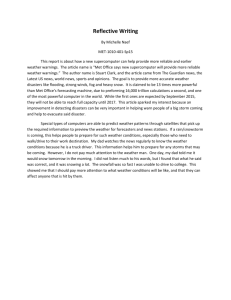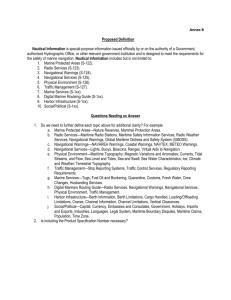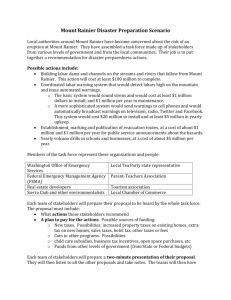Severe weather is the weather which requires extreme vigilance
advertisement

WORLD METEOROLOGICAL ORGANIZATION COMMISSION FOR BASIC SYSTEMS OPAG DPFS WORKSHOP ON SEVERE AND EXTREME EVENTS FORECASTING WSHOP-SEEF/Doc. 3.4(1) _______ (21.X.2004) ENGLISH ONLY TOULOUSE, 26-29 OCTOBER 2004 ESTABLISH GUIDELINES FOR IMPLEMENTATION OF A DEMONSTRATION PROJECT OF SEVERE WEATHER FORECASTING Sharing information between forecasting offices (Submitted by Dirk Heizenreder, DWD) Summary and Purpose of Document This document recalls the Report on the Pilot project "Cross Border Exchange of Warnings" provided by DWD and gives information about the EUMETNET project EMMA ACTION PROPOSED The Meeting is invited to study this document and make appropriate recommendations contributing to the implementation of (a) demonstration project(s) of severe weather forecasting. References: - Report on the Pilot project "Cross Border Exchange of Warnings" – DWD, German Contribution, Exeter October 2004-10-22 - Draft Proposal for a continuation of the EMMA-Project, UK Met Office, prepared for EUMETNET council meeting December 2004 CBS-DPFS/ WSHOP-SEEF /Doc. 3.4(1), p. 2 SHARING INFORMATION BETWEEN FORECASTING OFFICES 1. Preliminary Report on the Pilot project "Cross Border Exchange of Warnings" Introduction On its 13th session from 2 to 10 May 2002 in Geneva RA VI requested that a pilot project be started to create a network for bilateral exchange of severe weather warnings between neighbouring countries (Res. 7.1/1 (XIII-RA VI). The NMSs of Germany (DWD) and Austria (ZAMG) have taken central roles in the pilot project. First results of the activities of the DWD are reported below. Neighbouring offices The exchange of warnings between offices of the DWD and offices of neighbouring national weather services was partly initiated by the pilot project, partly has already been existing for years. The following table shows the details about the cross border partners. Office in Germany Leipzig München Office in neighbouring countries Usti nad Labem (Czech Republic) Innsbruck (Austria) Salzburg (Austria) Plzen (Czech Republic) Strasbourg (France) Strasbourg (France) Zürich (Switzerland) Offenbach Stuttgart Means of exchange The warnings are transported between the exchange partners by different means, e.g. fax is used to pass a special bilingual form between Germany and France or Germany and the Czech Republic. Textbulletins (with WMO header) are used by München to inform Austrian regional centres. Also a forum on the internet has been used to discuss complex weather situations. ZAMG (Vienna) sends emails to neighbouring regional offices telling that a warning has been issued. The warnings are displayed on ZAMG's web site. The regional centre Plzen uses DWD's web site for information about the warnings in Germany. The following table shows the details. Exchange partners Germany France Austria Switzerland Czech Republic Exchange via: fax textbulletins, email, WorldWideWeb fax fax, WorldWideWeb CBS-DPFS/ WSHOP-SEEF /Doc. 3.4(1), p. 3 First results A warning issued by a meteorological office is mainly helpful for the offices situated downstream. In western and central Europe westerly winds prevail. So warnings generated by Strasbourg may confirm the warnings worked out in Stuttgart. Austrian and Czech meteorologists may take advantage of the warnings generated by München or Leipzig. The exchange of information between neighbouring countries also helps to better judge the weather situation in space and time as well as the intensity of the weather phenomena. E.g. a severe weather situation with heavy rainfall in the alpine region could be judged better due to a cross border discussion in a Meteorisk internet forum. The forum discussion made it possible to coordinate the warnings in Austria and Germany as well as to realize the single voice principle across the border. The exchange of warnings between neighbouring countries helped to confirm the forecast intensity and location of a severe weather event, although determined by different methods. The post discussion of a severe weather event between neighbouring countries improves the understanding of the atmospheric process. The cross border exchange of warnings may also be mandatory. An example is Lake Constance bordering Germany and Switzerland. The regional centres in Stuttgart and Zürich have coordinated their warnings about storms on Lake Constance for years. So ships and sailing boats get the same warning signals from both sides of the lake. Conclusion In the pilot project emails are partly used to announce that a warning has been issued. These emails point at the NWS's web site where the warning is displayed. This means that the email inbox has to be checked permanently. However, in daily routine the warnings should be brought directly to the meteorologist’s desk. Most of the participating offices of the DWD would appreciate a continuing and routinely cross border exchange of warnings. First attempts are already made to extend the exchange to further countries. CBS-DPFS/ WSHOP-SEEF /Doc. 3.4(1), p. 4 2. Introduction to the European Multi-service Meteorological Awareness system (EMMA) The European Multi-service Meteorological Awareness (EMMA) Programme started in 2001, with a consortium of 4 European Met services (UK Met Office, Météo-France, DWD, KNMI) with the aim of demonstrating a European meteorological risk awareness service: o using graphical information across the Internet; o easily accessible, in a form readily understood at a glance; o understandable throughout Europe; o offering more detailed information from the existing national warning services, and risk qualification and behaviour information; o concerning phenomena like strong winds, heavy rains, fog, forest fires risks, avalanche risks, storm surges, etc; o for use by forecasters, authorities and the general public. Initial workshops in 2002 brought together European forecasters to explore the possibility of harmonisation of existing services and to establish principles. Work in 2003 and 2004 concentrated on a technology demonstration. The programme formally finished in September 2004. Current Achievements within EMMA An international web based awareness system for meteorological severe weather warnings has been successfully trialled with several NHMS. In detail: o A developmental Web server is running at the Met Office in Exeter, displaying the state of severe weather warnings sent from Austria, Belgium, Italy, and UK. Finland and Switzerland will be incorporated very soon. The Netherlands, France, DWD could be incorporated if resources allow. o The EMMA web pages are visible across the Internet to known users with standard web browsers (MSWindows, Apple MacOS, Linux; Internet Explorer, Netscape, Mozilla Firefox). o A two level map scheme had been adopted. The top level is an interactive map of European countries. At the next level, a map of one country displays its severe weather regions with indicative pictograms. The countries, or regions, are coloured. o A third tier displays actual weather warnings and links to NHMS information. CBS-DPFS/ WSHOP-SEEF /Doc. 3.4(1), p. 5 A four colour scheme of green, yellow, orange and red has been adopted, with white signifying that no recent information has been received, and grey for areas outside of the programme. o Green – No severe weather expected, no risk to the public. No special awareness required o Yellow – Weather events expected but not out of the ordinary. Potentially dangerous, but not unusual phenomena have been forecast. o Orange – Potentially dangerous, and unusual phenomena have been forecast. o Red – Dangerous and exceptionally intense meteorological phenomena have been forecast. o The colours were carefully chosen to give clear discrimination for colour blind people, avoiding the need for a separate monochromatic display option. o Currently, ten categories of severe weather or events have been incorporated: Wind, Rain, Snowfall, Thunderstorm, Fog, High temperature, Low temperature, Coastal event, Forest fire, and Avalanche. Users can select to view only those of interest. o Warnings for the next 24 hours are displayed. New warnings are incorporated into new displays immediately. o Thresholds and criteria for the warnings are all determined at the national level, as are the mappings to the colour scheme. The system allows colour states to be transmitted without specific thresholds being set. o The displays have been designed to be multi-lingual, with user choice (e.g. a French speaker could use a browser in Italy to look at the situation for Austria). o The technical system uses a secure architecture to make it resistant to malicious attacks from the Internet. The database and web servers are separated behind a ‘firewall’ into separate DMZs (De-Militarized Zones). o The messages are transmitted in XML formats, and use XML Schema technology to automatically validate the syntax of the messages. o The technical design successfully used ‘Use Cases’ to clarify the specification and testing. o Some progress was made towards defining a framework in which the expectations of the end user could be managed. In particular, the concept of the ‘return period’ of a colour coded area has led to some harmonisation. o There has been a consensus that ‘best practice’ national schemes should have multi level thresholds that are outcome orientated and a range of forecast periods, o Some NHMS have decided to change their national severe weather warning schemes in response to EMMA. o Representative and objective performance measures, such as response time, were agreed for any operational system.






